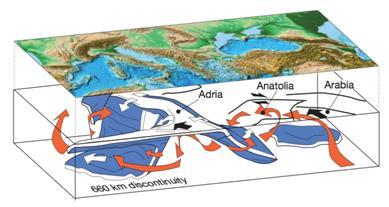
A new study, published in Nature, casts light on why volcanic eruptions can take place far away from plate boundaries, writes Harriet Jarlett.
Geoscientist online, 12 July 2010
The study, published in Nature, suggests that pressure from the mantle can raise mountains and cause volcanic eruptions, even far away from subduction zones. Thorsten Becker from the University of Southern California, and Claudio Faccenna of the University of Rome, used geodesic models to demonstrate that anomalies in the mantle can affect surface convection and plate movements.
“The rise and subsidence of different points of the earth is not restricted to the exact locations of the plate boundary”, says Becker. “You can get tectonic activity away from a plate boundary”.
The study focuses on mobile belts in the Mediterranean, computing global mantle flow on the basis of recent high-resolution seismic tomography to look at the role buoyancy and plate motion induced circulation have on the mantle. Mobile belts are long-lived deformation zones made up of crustal fragments, scattered over large areas inside convergent boundaries, of which the Mediterranean is a good example (see Figure 1). However, the Mediterranean, despite being well defined, has a mosaic of microplates that move and deform independently from the overall plate convergence. The origins of topographic features in the area are often contested.
The model used seismic tomography to predict temperature anomalies, which would imply density anomalies. Mantle flow is produced by these density anomalies and puts a stress onto the lithospheric plates to produce both horizontal and vertical motions.
The authors found that mantle that sinks at the plate boundary flows back up farther away, pushing on the crust and causing uplift and crustal motions detectable by global positioning systems. These regions of uplift were found to coincide with mountain belts, like the Massif Central in France. They also noted that the origin of alkaline volcanism is related to mantle dynamics. Therefore it is possible that volcanism can be caused by decompression melting related to the large-scale return flow seen at the back arc of the western Mediterranean.
Seismicity in the Mediterranean is found mostly in the Wadati-Benioff zones and beneath the Alboran region, where large earthquakes have occurred as recently as April 9th 2010. It is possible that by constraining the mantle dynamics in this region using seismic tomography and correctly explaining the observed topography and microplate motion that this model could be a tool in defining other complex arcs such as the N.A. Cordillera or the Himalayan-Tibetan collision zone and helping constrain their uplift rates and hot spots of volcanism.
However, not everyone is in agreement about the importance of the findings. Rinus Wortel and Rob Govers from Utrecht University consider there to be fatal flaws in this model and believe that “the idea that flow in the lower mantle contributes to the formation of the Earth’s surface is not new” and has been studied before in southern Africa
2. They warn of trusting these models too soon when they are “just one step” closer to a fully dynamic model of mobile belt systems. This is particularly important when we remember that putting our trust in these models can supposedly predict major earthquakes and volcanoes and put lives at risk.
Despite the exciting new data produced, and another jump forward in understanding mantle dynamics, we will need many more advanced models before we can fully understand the kinematics in an advanced and complex region, particularly one such as the Mediterranean. Only then can we begin to apply James Hutton’s principle, quoted by Wortel and Govers in their reply to the original paper, “the present is the key to the past…the present is the key to the future”.
References:
1 Faccenna, C. a. B., Thorsten W. Shaping mobile belts by small-scale convection. Nature 465, 602-605 (2010).
2 Wortel, R. & Govers, R. Geoscience: Driving Earth's surface motions. Nature 465, 559-559 (2010).